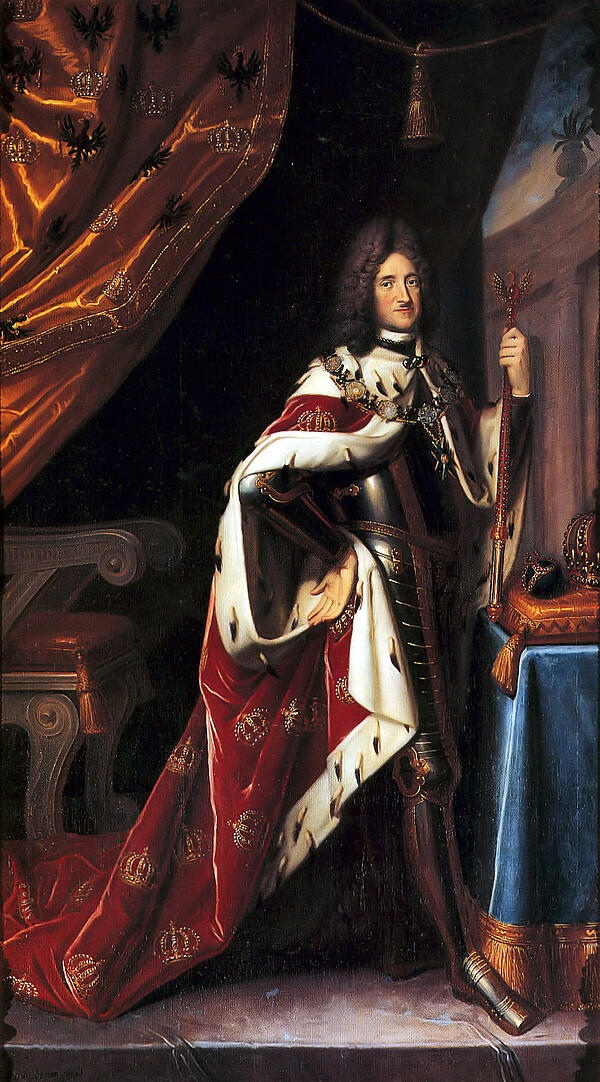Frederick I of Brandenburg
Frederick I of Brandenburg became Elector and King of Prussia following the death of his father, Frederick William, in 1688. During his reign, he elevated Prussia to a monarchy and and continued the policy of territorial expansion initiated by his father.
Born the third son of Frederick William on 11 July 1657, Frederick I succeeded to the electorate in 1688.
Unlike his father, Frederick had a less direct role in the day-to-day running of the government, which he primarily left to his chief ministers. He kept an impressive court and relied on the advice of the prime minister and his boyhood tutor - Eberhard von Danckelmann.
Danckelmann was a talented man who continued the policies of the Great Elector, continuing with the centralisation of government and further extending the authority of the crown. Count Kolbe von Wartenberg took over as chief minister from 1697 to 1711. He was notably less successful than his predecessor.
By the time Wartenberg was appointed, Brandenburg-Prussia had become accustomed to centralised monarchical power.

Frederick William
Brandenburg’s population expanded significantly during Frederick william’s reign. This was largely due to his policy of allowing refugees to populate the state. As a result, by the time of Frederick, Brandenburg-Prussia was seen as the champion of Protestantism.
Frederick William’s policies certainly benefited Frederick I, who enjoyed twice as much royal income and a highly effective civil service which was created during Frederick William’s reign. What’s more, the army increased by 40 per cent, from 50,000 to 30,000. . Royal income for Frederick doubled and the civil service created during his reign worked very efficiently by the time of Frederick I. He had also increased the army in size to 50,000 from 30,000 - a 40 per cent increase.
Frederick I’s power was extended even further when, in 1702, a Supreme Court of Appeal was created in Berlin. This meant there was no longer any right of appeal to the Holy Roman Empire, giving Frederick more power to make laws.
Monarchy
Brandenburg-Prussia made it an attractive ally. Its reputation also allowed Frederick to convert the state into a monarchy. By the reign of Frederick I, the title 'Elector' had declined in status and importance, making the title ‘King of Prussia’ especially attractive.
The Holy Roman Emperor, Leopold, called on Frederick for help during the War of Spanish Succession. In return providing Leopold with 8,000 soldiers, Frederick was rewarded with permission to himself King of Prussia.
During his reign, Frederick embarked on an impressive building campaign. His lavish approach to kingship included castle building and collecting of works of art.
Culture and Education
However, Frederick did not only focus on his own status. In the 1690s he created schools, universities and cultural centres that reflected Brandenburg-Prussia's rise as a cultural, intellectual and educated state in Europe. In 1694, a university had been established at Halle, which further boosted the state’s intellectual credentials.
In 1696, Frederick established an Academy of Art and an Academy of Science a year later. In his development of culture, Frederick was greatly influenced by wife, Sophie Charlotte. She wanted to promote the state’s cultural and intellectual output so that it wouldn’t be known only as a military state.
Frederick I pushed forward with his father's attempts to modernise the infrastructure of Brandenburg by building more canals and roads and cultivating waste land to expand Brandenburg’s agricultural base.
Foreign Policy
Frederick’s foreign policy was largely focused on a war with Louis XIV of France. Brandenburg’s army fought with WIlliam III of the United Provinces and gained a reputation as being well-trained, fearless soldiers. His growing reputation made William a desirable ally for other European powers, while the subsidies received for the troops made Brandenburg a wealthy state.
By the time of Frederick’s death in 1713, Brandenburg-Prussia was considered Europe's greatest force. France had been dragged down by the reign of Louis XIV; Spain had lost much of her power; and no German state was able to match Brandenburg-Prussia.
Brandenburg-Prussia played a role in the Great Northern War, which was fought between Sweden’s Charles XII and a coalition led by Peter the Great. Prussia entered the Great Northern War in March 1715. Prior to this much of the Prussian army had been involved in various theatres of the War of Spanish Succession.
The capture of Stettin in September 1713 had created an uneasy relationship between Prussia and Sweden. There then followed an uneasy period in Prusso-Swedish relations before war broke out, following the conclusion of the War of Spanish Succession.
Prussia's primary objective during the war was to clear Swedish forces from their remaining strongholds in Germany. The Prussians were part of the Allied force which besieged Stralsund between July 1715 and it's surrender in December 1715 and also of Wismar between March and April 1716. During the siege of Stralsund an Allied force, including Prussian troops, invaded the island of Rugen. This was vital to the Swedish war effort as it was the only supply route to besieged Stralsund. This invasion led to the Battle of Stresow in which the Swedes tried unsuccessfully to halt the Allied occupation of Rugen.
Personal life
Frederick married three times during his lifetime. His first wife was Elizabeth Henrietta of Hesse-Kassel, with whom he had one child. The marriage - a love match - was tragically ended after only four years when Elizabeth died of smallpox. Frederick then married Sophia Charlotte of Hanover in 1704, with whom he had two children, only of one of which survived beyond infancy. In 1708, he married Sophia Louise of Mecklenburg who survived him.
MLA Citation/Reference
"Frederick I of Brandenburg". HistoryLearning.com. 2025. Web.
